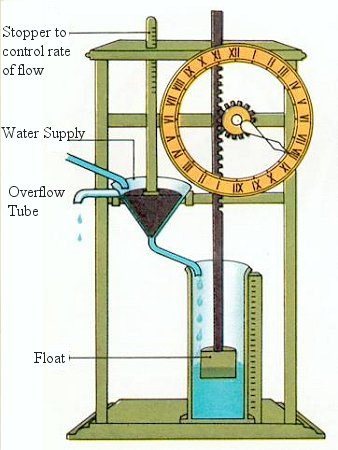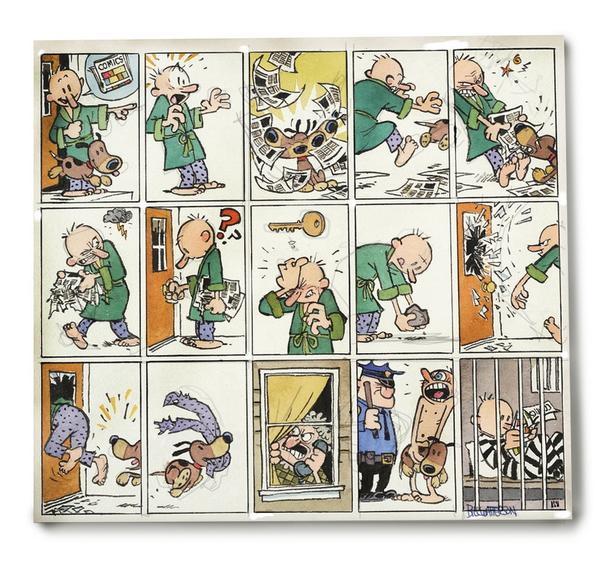I just spent the last hour turning all my clocks back.
So much for gaining an hour. . .
Why, exactly, did we ever bother with
Daylight Savings Time?
A History of Time-Keeping
Supposedly it was to make better use of daylight and conserve energy. Daylight Savings Time has only been in use for about 100 years, but, believe it or not, ancient civilizations were known to have a similar practice where they would arrange their schedule to the sun's schedule. (I think that's called adapting.)
Gnomons weren't particularly accurate because they measured solar time, which changed a bit each day. Clock time, on the other hand, measured the same amount of time (24 hours) between one noon and the next, regardless of the season.
Other than the gnomon, The clepsydra is likely the oldest time-measuring instrument. Babylonians may have been the ones who invented it. In 1600 BCE, maybe even earlier, the clepsydra was also used in Egypt to measure
predetermined periods of time. Unlike the sundial, it could be used on cloudy days and at night. It was simply a container that relied on a steadily rising or falling water level in a container to mark the passage of time. The inside of the container was etched with graduated "hour" marks.
 |
The Clepsydra
Notice the 24-hour clock
|
The Romans used a version of the clepsydra that consisted of a floating rod that rose (as a result of a regulated water flow) to mark the time of day. This water flow was eventually used to move hands on a circular face that had 24 "hours" marked on it. The hands would change based on how much water flowed into the clock. (Owning a water clock was a status symbol--only rich people could afford one.)
Water clocks were used to control how long people were allowed to talk in the Senate. (Romans sure loved to go on and on. . .) Two water clocks equaled about one hour.
Of course, it had other uses, like keeping track of time in a race.
Whatever we may do to the contrary,
mother nature has determined
the seasonal rhythms of daylight and moonlight,
sunshine and shadow,
and it is good.
ASSIGNMENTS FOR
THE WEEK OF
NOVEMBER 2-6
Science
Plate Tectonics - A Documentary
Tuesday: From last week: Cut out your colored puzzle pieces and piece together how you think Pangea looked. Then, to preview PLATE TECTONICS--read article, then scroll to the bottom to answer 2 questions.
FYI:
We'll also set up Earth Science Interactive Notebooks and include our Pangea puzzles.
Wednesday:
- Close read of "Alfred Wegener and Continental Drift"
- Group Activity: Complete "Writing Frame:Continental Movement
The Sid Shuffle -- Contintental Drift
Thursday (to finish up Monday):
Plate Tectonics WebQuest
OK awesome quest seekers! Use the dynamic links on THIS site to complete the packet provided to you. Responses should be well thought out and complete. This will become a part of your Interactive Science Notebook.
"Ring of Fire"
For more information:
SOCIAL STUDIES
Your Plan of a Tackk
Everyone seems to really be into their projects, which we will finish up in the next couple of days. Here's what I need from you.
(2.) Be sure you have the urls for each and every site you used. Did you put these on a Google Doc like I asked? If not, you have a bit of backtracking to do here, too. Bummer!
(3.) Share your Tackk with a peer. Use the Tackk Checklist and Content Options to guide you.
(4.) Final touches will be made to TACKK projects in preparation for their being displayed on this blog!
(4.) Final touches will be made to TACKK projects in preparation for their being displayed on this blog!
Ziggurat models due Monday!
(Want to know why? No School Friday. . .)
- Does your Ziggurat demonstrate your best effort?
- Are there at least four levels?
- Are all the parts labeled? (Go HERE to find the 8 parts and where they're located.)
- Is it an engineering masterpiece?
~ALSO~
Mesopotamia Test on
Tuesday, November 10
Be ready by reviewing:
for students of all skill levels.
LANGUAGE ARTS
Last November, Watterson, a very private, reclusive man, surprised his legion of adoring fans by creating his first comic strip in 20 years. It was a 15-panel comic strip poster promoting the Angoulême International Comics Festival, held in Angoulême, France last year from the end of January through February.
This comic strip may lack words, but it tells a rich and expressive story.
Take ten minutes to write a short narrative based on this comic strip.
Remember narratives are just stories.
Now that we've practiced writing narratives with our "Scary Stories" assignment, we'll begin our PPPNPs -- our
Portfolio-Perfect Personal Narrative Projects --
Portfolio-Perfect Personal Narrative Projects --
We're writers. Amazing, elaborate stories are within each of us, just begging for an audience. Our greatest challenge [in crafting narratives] is "beginning" well--that is, producing the kind of lead that will grab the reader and not let go. It doesn't matter if it's fiction or non-fiction, a strong beginning is what sets the tone, establishes the intent, the purpose, of the piece, and determines the author's "voice." Want to captivate your reader? Begin well.
We'll explore THIS site for some insight (a little word play, here) into writing great beginnings for our own narratives. Want some advice? Pay attention to what good writers do. Play around with different ideas for leads and see what works best for you. Don't be boring. (Sorry; it had to be said. . .)
We'll gather some tools this week and craft our own beginnings to PERSONAL NARRATIVES. Exemplars will be posted on this blog!
Nothing grabs a person's attention like a good beginning. Check THIS out for great examples of how to write a narrative lead.
PERSONAL NARRATIVE WRITING -- STEP-BY-STEP SUPPORT.
MATH
6.NS.A.1 Interpret and compute quotients of fractions, and solve word problems involving division of fractions by fractions, e.g. by using visual models and equations to represent the problem.
Monday: Lesson 2.8: Model Mixed Number Division. Share & Show pgs. 115-116. Homework, pgs. 117-118.
Tuesday: Lesson 2.9: Divide Mixed Numbers. Share & Show pgs. 121-122. Homework, pgs. 123-124
Wednesday: Lesson 2.10: Problem-Solving - Fraction Operations pgs. 127-128. Homework, pgs. 129-130.
Thursday: Chapter 2 Review Test, pgs. 131-134
Thursday: Chapter 2 Review Test, pgs. 131-134
Dividing Mixed Numbers
Problem-Solving -
Fraction Operations
SPELLING
Test from last Friday
Because of the short week, we won't have Spelling this week. Be sure you're all caught up and turn in your books!
READING
Bud Not Buddy
By Christopher Paul Curtis
Along with classroom discussion/activities:
Monday: Chapter 12 -- Complete Exit Ticket.
Tuesday: Chapter 13 -- Complete Exit Ticket.
Wednesday: Chapter 14 -- Complete Exit Ticket
Thursday: Chapter 15 --Complete Exit Ticket.
Oh, by the way. . .
Have you filled out your contract
for November?
Make me smile. . .
Fall back gif feather image clock animated image Egyptian clepsydra image Roman Clepsydra image Roman senator image Roman sundial cartoon Roman guy in chariot animated gif Apache blessing image aspen leaf border gif ak Calvin & Hobbes cartoon New Watterson 15 panel cartoon poster Hobbes on a wire animated gif Story structure cartoon image boy looking at word Bud, Not Buddy image cranky man image Mesopotamia map Nov 20 image mail ziggurat Peanuts comic strip

.gif)








